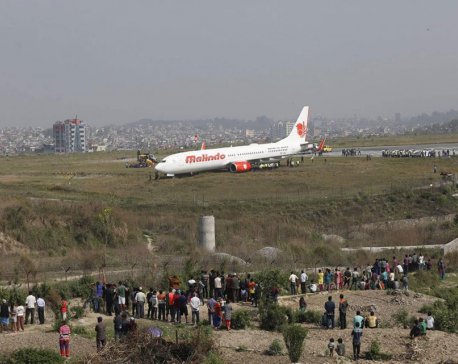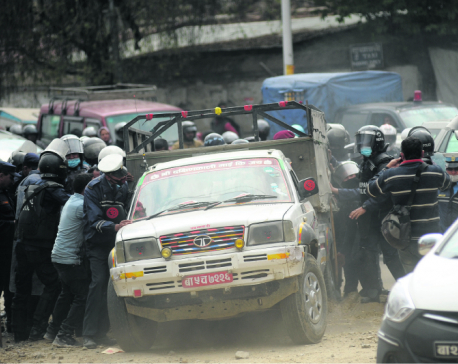
OR
Unorganized management of TIA causing air traffic congestion
Published On: May 28, 2018 08:17 AM NPT By: Arpana Ale Magar
KATHMANDU, May 28: Air traffic congestion at Tribhuvan International Airport (TIA) has become a major issue, threatening smooth operation of the country’s only international airport.
All the stakeholders, including Ministry of Culture, Tourism and Civil Aviation, are putting their efforts to minimize air traffic congestion at TIA. The government blames the congestion to increased number of international flights to Nepal and growing number of aircraft of domestic companies.
However, these are not only the reason. Lack of parking bay, manpower crunch, and inefficient management of slot have also been causing air traffic congestion. One of the major reasons is the limited parking bay. TIA currently has 17 parking bay for domestic airlines and nine for international airlines. According to TIA, around 20-25 domestic aircraft cover parking bay at TIA every night which is more than the airport’s capacity.
Minister for Culture, Tourism and Civil Aviation, Rabindra Adhikari, blames this to unethical behavior of domestic airlines. According to Civil Aviation of Nepal (CAAN), majority of domestic airlines bring their aircraft to TIA for parking. As they begin their first flight from Kathmandu, that increases air traffic congestion during the morning time.
To do away with the problem, tourism ministry has announced that it was bringing a policy that requires airline companies to park 50 percent of their aircraft at other airports of the country.
TIA is the base of Nepal Airlines, Himalayan Airlines and Mountain helicopter. Likewise, Saurya Airlines has bases in Kathmandu Biratnagar, while Kathmandu, Pokhara, Surkhet and Nepalgunj are the designated bases for Shree Airlines. Similarly, Tara Air has bases in Kathmandu, Pokhara and Nepalgunj, while the base of Simrik Air is Nepalgunj. Although CAAN has designated bases for aircraft, most of the domestic airlines have been parking their aircraft at TIA only.
Buddha Airlines alone has 10 aircraft and all of them make their first flight from TIA.
Moreover, the unmanaged slot distribution is also a reason behind air traffic congestion at TIA. Allowing slot to airlines companies as per their requirement by overlooking TIA’s capacity has aggravated the situation.
“I admit that the authorities made some mistakes in the past. Now, TIA, CAAN and the ministry are putting joint efforts to correct them,” Raj Kumar Chhetri, general manager of TIA, told Republica. He also reminded that the ministry recently concluded feasibility study of Kavre Airport in order to reduce air traffic congestion at TIA to some extent. “Besides, TIA started 21-hour operation from May 21 to ease air traffic congestion,” added Chhetri.
TIA is currently handling the business of international airlines, domestic airlines, helicopters and a fleet of Nepali Army. Similarly, some of the mountain flights are also being operated from Kathmandu. According to Chhetri, airlines are operating mountain flights from Kathmandu as it is less costly than to operate flights from Pokhara.
TIA is now operating more than 400 flights a day including domestic fights.
‘MORNING AIR TRAFFIC DOWN BY 25 PERCENT’
As Goma, Sita and Tara Air have moved some of their aircraft to Nepalgunj, around 25 percent of morning air congestion has reduced at TIA, according to Chhetri.
Ghana Shyam Acharya, the spokesperson for Airlines Operators Association of Nepal (AOAN), said that Goma, Sita and Tara Air have moved nine aircraft to Nepalgunj, targeting the Kailash-Mansarovar passengers.
Assuming that each aircraft operates five flights a day, altogether 45 flights have move to Nepalgunj from TIA. “This has reduced around 25 percent of air traffic from TIA during morning time,” Chhetri added.
He, however, said that this transfer is seasonal. “After four or five months, these aircraft will again come back to TIA,” he said, adding: “That is why we are requiring airlines to park 50 percent of their aircraft outside TIA.”
You May Like This

TIA to operate 24 hours today to ease air traffic congestion
KATHMANDU, April 20: Following hours of delay after a Malindo Airlines skidded off the runway during takeoff yesterday night, the... Read More...

Traffic congestion on Jogbani border as Mirgunj Bridge sustains damages
BIRATNAGAR, Oct 26: A traffic congestion along the diversion road near Jogbani border has increased after the vehicular movement was... Read More...

Traffic congestion a nightmare for Valley denizens
KATHMANDU, March 20: For the past few months, Yogesh Shrestha, a teacher known for his punctuality and promptness, has not... Read More...










Just In
- NRB introduces cautiously flexible measures to address ongoing slowdown in various economic sectors
- Forced Covid-19 cremations: is it too late for redemption?
- NRB to provide collateral-free loans to foreign employment seekers
- NEB to publish Grade 12 results next week
- Body handover begins; Relatives remain dissatisfied with insurance, compensation amount
- NC defers its plan to join Koshi govt
- NRB to review microfinance loan interest rate
- 134 dead in floods and landslides since onset of monsoon this year








Leave A Comment